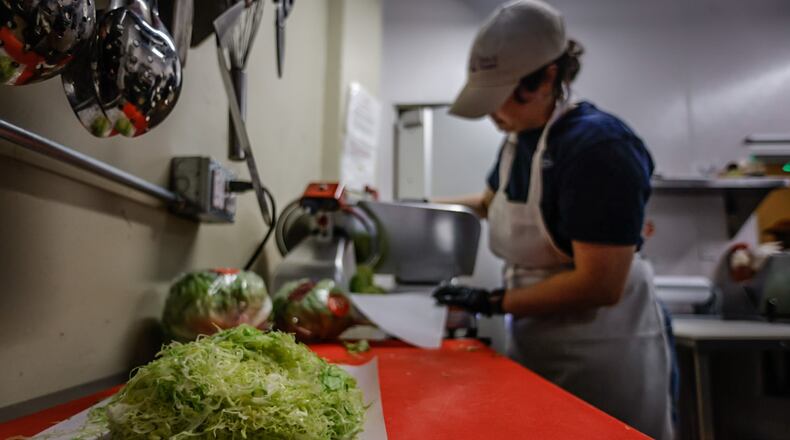“More than about half of this of the lettuce for the U.S. market is grown in a part of California called the Salinas Valley,” Barker said. “When something goes sideways, it can be extremely sensitive to the supply and ... anytime there’s less supply, the pricing goes up, and that’s what we’re seeing right now.”
Tony & Pete’s Groceries & Coldcuts at 129 East Third St. in downtown Dayton was paying $60 for 24 heads of iceberg lettuce last summer, according to co-owner Justin Simmons. That was “a little elevated” compared to what other restaurants were paying earlier this year, but not as bad as the $110 per case he had to shell out just two weeks ago.
“It’s hard for a small business to bear that burden, especially when we are dependent on iceberg (lettuce),” Simmons said. “We shave it down my deli slicer. The problem for us was, we would get these lettuce heads that ... were relatively anemic and there was no yield. So we’d put them on the deli slicer and ... there was no density, so we couldn’t shred the lettuce down.”
That caused the shop to shift gears and create new menu items that used arugula as a green, he said.
“We never thought we’d see the day where arugula was the more affordable option,” Simmons said. “We really had no choice, since we are so dependent on shredded iceberg lettuce, but to ride it out and just let it eat into our margins.”
A lot of restaurants use iceberg and romaine lettuce for salads, which are “an integral part of casual dining and fine dining,” Barker said.
“That puts tremendous pressure on those restaurants to either decide not to serve the salads, or they’ve got to adjust the prices to help them handle the cost,” he said.
Dan Apolito, co-owner of Archer’s Tavern locations in Centerville and Kettering and Stone House Tavern in Waynesville, said the restaurants’ salads are made with the same basic mix cut fresh each day: romaine lettuce and iceberg lettuce plus shredded carrots and cabbage.
Apolito said he was paying $1.47 for a head of iceberg lettuce in early summer, or about $35 a case, and about $1.25 for a head of romaine lettuce, or about $30 a case.
By the beginning of December, it was costing him $131 to get a case of iceberg lettuce, or about $5.46 per head, and $112 to get a case of Romaine, or about $4.67 per head.
That’s a more than 270% price increase for each type of lettuce in about half a year.
Apolito, who has been in the restaurant business for 25 years, said what he’s seeing with the lettuce shortage is “unprecedented.”
“The first thing we’ll do is see if there is another vendor that we might be able to get it a little less expensive, but we don’t really have many options,” he said. “We have one main food vendor and then we have two alternatives we can use, but we were seeing these prices across the board, so it wasn’t a vendor issue.”
Apolito said he’s seen a very slight reduction in costs over the last two weeks, but it’s still significantly higher than usual.
“We’re still talking about $4 a head compared to that $1.25 we used to pay, so we’re really stuck because you know it wouldn’t financially make sense to (raise prices and) reprint menus,” he said. “We feel like our guests that want a salad still should be able to come in and get a salad.”
In the end, each restaurant must make the decision on what’s the best way to handle this and other increases on products they use for items on their menu, said Barker of the Ohio Restaurant Association.
“If you just eat the increased costs for lettuce and you serve a lot of salads, you’re likely to be hurting hard right now on your profit-and-loss statement,” he said.
Some fast food giants, including Chick-Fil-A, Subway, Taco Bell and Wendy’s, went so far as to temporarily eliminate lettuce as a topping option on a sandwich or burger in previous weeks.
A sign on display at Wendy’s at 4003 Wilmington Pike in Kettering earlier this month told customers the restaurant may not have lettuce available for sandwiches and salads.
“The lettuce we use has been impacted by adverse weather in the growing region,” the sign said. “This is an industry-wide issue.”
Barker said customers will understand if restaurants explain it.
“If you just take things off and don’t say anything at all, they could mistakenly think you’re changing the menu or shorting them something that they should should be getting,” he said.
About the Author


